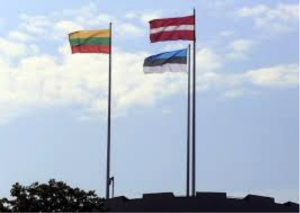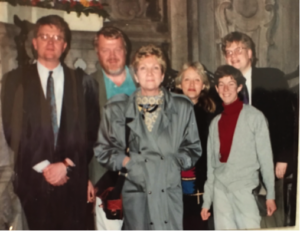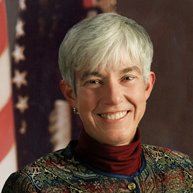by Beatrice Camp
When General Vernon Walters, our famously outspoken ambassador in Germany, visited Stockholm in the fall of 1989, we arranged a press briefing at the ambassador’s residence. His prediction that Germany would be reunited within five years made headlines and drew a rebuke from Washington, which was not yet talking publicly about such possibilities. Of course, things moved much faster than even Vernon Walters could predict.
During four years at the U.S. embassy in Stockholm, 1989-1993, we saw the Berlin Wall come down, the Soviet Union dissolve, and the Baltic states regain their independence.
When the unfamiliar flags of Estonia, Latvia, and Lithuania first appeared over a hotel in Stockholm, we puzzled over what they represented. Suddenly the concept of “captive nations”, a term dating from the Eisenhower era, changed from a quaint cold war trope to political reality. After some hesitation to see which way the wind was blowing, the Scandinavians rushed to recognize the sovereignty of the three Baltic states. Reporters were calling the embassy to ask whether the U.S. had conveyed recognition yet. There was a kind of holier-than-thou superiority in being first.

Thanks to our cold war support for “captive nations”, we had the satisfaction of pointing out to inquiring journalists that the U.S. (unlike Sweden, we didn’t have to add) had never recognized the incorporation of the Baltic states into the Soviet Union. Their embassies in Washington remained open during the whole period of Soviet rule; one of the original Baltic ambassadors was still in Washington, over 80 years old by this time.
In fact, as I later learned, it was a little more complicated. According to an oral history by our first ambassador to Latvia, Ints Silins, “we were far from the first” to recognize the new Baltic governments. “The reason for that was the policy of President Bush, that is, the elder George Bush, his policy of prudence vis-à-vis the Soviet Union…. He did not wish to move so rapidly into this very sensitive part of the former Soviet Union as to provoke a Soviet counter-reaction. He wanted to move slowly and carefully so as not to jeopardize Baltic independence or Soviet stability. That’s why we didn’t rush in to be the first to recognize…We knew that, as I said, we were responsible for holding open the possibility of independence for the Baltic States over all these decades. So, no reason to shout about it.”
Despite their eagerness to assist in rebuilding the Baltics, the Swedes found themselves on the wrong side of historical justice when these restored countries asked for the return of gold they had deposited in Sweden, the UK, the U.S., and other countries before World War II. After the Soviets took over these nations and asserted that the gold now belonged to them, Sweden was one of the countries that complied. Having long since turned over the gold to the USSR, Sweden resisted the idea of having to pay back an equivalent amount to the new states. Instead they argued that Sweden was providing aid in the amount of the gold. The Baltics rejected this, pointing out that “aid is aid, our gold is our gold, give it back”. Sweden eventually did, but it wasn’t pretty.

Unsure how long this new situation would hold, we seized the opportunity to see for ourselves, as tourists. Regular cruises traveled between Stockholm, Helsinki, and other Baltic ports; these were popular short trips because they were duty free and provided a way around the high liquor taxes in Sweden. Suddenly it became possible to travel as well to Tallinn, Riga, and Leningrad – which turned into St. Petersburg during our time in Stockholm. Our commute to the embassy took us past the port, which had a directional sign for Leningrad; one day the sign read “St Petersburg” instead. We saw the changes in small as well as big ways.
In August 1990 we took a weekend trip to Estonia, figuring that we should seize the opportunity before the Soviets cracked down. No one knew whether this opening would last. Two years later the Soviet Union no longer existed and the U.S. was establishing diplomatic posts in the Baltic countries as well as other former Soviet republics. When we visited Latvia in 1992, the brand new U.S. embassy was still pulling together equipment and staff; the Public Affairs Officer had nothing but a desk in his office. On the down side, this Baltic build up had negative consequences for us in Sweden as well at other embassies — the foreign service staff had to come from somewhere, which led to cut backs in Stockholm and elsewhere.
Embassy programs also adjusted to reflect the new European landscape. With the North Atlantic Treaty Organization (NATO) alliance central to the U.S. goal of a Europe, “free, whole, and at peace”, the U.S. Information Agency (USIA) ran a program to familiarize European journalists with NATO institutions. One standard stop was the Fulda Gap in Germany, which NATO war planning considered a likely route for a Soviet tank attack on West Germany.

In 1990, when I led one of these NATO tours for Swedish journalists, the Fulda Gap had lost its strategic significance and was no longer part of the schedule. Instead, in addition to the standard briefings in Brussels and a tail-hook landing on an aircraft carrier off Naples, we included a stop in Prague, the first time one of these tours visited a non-NATO country.
Although we didn’t know what to expect from this innovation, the result was eye opening for all of us. The Swedish journalists were taken aback by the enthusiasm of Czech foreign ministry officials for NATO; the Europe- and U.S.-skeptic Swedes were forced to re-think their assumption that a former Warsaw Pact nation would not want to place itself under the western alliance.
The Czech Republic joined NATO eight years later, along with Hungary and Poland. Estonia, Latvia, and Lithuania became members in 2004.![]()

Beatrice Camp served as embassy spokesperson in Stockholm 1989-1993. She also held foreign service assignments in Beijing, Bangkok, Budapest, Chiang Mai, Shanghai, and Washington, DC. She is Editor of the American Diplomacy Journal.
